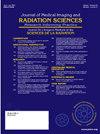Navigating the digital shift in radiologic technology education: Distance learning and its implications: A narrative literature review
IF 1.3
Q3 RADIOLOGY, NUCLEAR MEDICINE & MEDICAL IMAGING
Journal of Medical Imaging and Radiation Sciences
Pub Date : 2025-04-03
DOI:10.1016/j.jmir.2025.101895
引用次数: 0
Abstract
Background
This narrative review examines the current state of distance learning in radiologic technology education, focusing on recent trends, the challenges faced by educators and students, and innovative teaching strategies that promote student engagement and active participation. By analyzing data from various sources, including academic studies and institutional reports, the review identifies key trends in online learning methodologies and technologies.
Methods
The literature search for this review was conducted through the City University of New York (CUNY) online library, which provides access to multiple databases, including PubMed, Scopus, EBSCOhost, and Frontiers. This allowed for a comprehensive review of peer-reviewed journal articles, textbooks, institutional reports, and online articles related to distance learning in radiologic technology education. The search terms used included “distance learning,” “online education,” “radiologic technology,” “virtual simulations,” and “innovative teaching strategies.” Boolean operators (AND, OR) were applied to refine the search results, and truncations were used where necessary to broaden or narrow the scope. An initial search yielded over 100 sources, which were then screened for relevance, credibility, and methodological quality based on the titles and abstracts. The search was limited to sources published in English between 2017 and 2024, and a total of 30 sources were selected based on their alignment with the study's objectives and methodological soundness. To structure the review, a systematic thematic categorization approach was applied to identify and synthesize key themes emerging from the literature. This structured method ensured a comprehensive and organized synthesis of findings relevant to distance learning in radiologic technology education.
Results
The review identifies key trends, including the rise of hybrid models and virtual simulations in education. Challenges such as maintaining student engagement, practical skills training, and access to technology were prevalent. Solutions like virtual simulations and hybrid learning approaches were proposed to address these challenges.
Discussion
The integration of digital technologies has expanded the reach of radiologic technology education but presents ongoing challenges, particularly with practical skills training. Innovative strategies, such as virtual simulations, have the potential to address these gaps and enhance student engagement.
Conclusion
Distance learning offers advantages such as accessibility and cost-effectiveness, but it also faces challenges, including technological barriers and maintaining educational quality. Investment in technological infrastructure and continuous professional development for educators are crucial for optimizing distance learning in radiologic technology education. Future research should further explore these strategies to improve outcomes in the field.
引导放射技术教育的数字化转变:远程学习及其影响:叙述性文献综述
本文回顾了放射技术教育中远程学习的现状,重点关注了最近的趋势、教育者和学生面临的挑战,以及促进学生参与和积极参与的创新教学策略。通过分析各种来源的数据,包括学术研究和机构报告,该报告确定了在线学习方法和技术的主要趋势。方法通过纽约城市大学(CUNY)在线图书馆进行文献检索,该图书馆可访问PubMed、Scopus、EBSCOhost和Frontiers等多个数据库。这允许对同行评审的期刊文章、教科书、机构报告和与放射技术教育远程学习相关的在线文章进行全面审查。搜索词包括“远程学习”、“在线教育”、“放射技术”、“虚拟模拟”和“创新教学策略”。应用布尔运算符(AND、OR)来优化搜索结果,并在必要时使用截断来扩大或缩小范围。最初的搜索产生了100多个来源,然后根据标题和摘要筛选相关性,可信度和方法质量。搜索仅限于2017年至2024年间发表的英文来源,根据它们与研究目标的一致性和方法的合理性,总共选择了30个来源。为了构建这篇综述,我们采用了系统的主题分类方法来识别和综合从文献中出现的关键主题。这种结构化的方法确保了与放射技术教育中远程学习相关的研究结果的全面和有组织的综合。报告指出了主要趋势,包括混合模型和虚拟仿真在教育中的兴起。保持学生参与、实践技能培训和获取技术等挑战普遍存在。为了应对这些挑战,提出了虚拟模拟和混合学习方法等解决方案。数字技术的集成扩大了放射技术教育的范围,但也提出了持续的挑战,特别是在实用技能培训方面。创新策略,如虚拟模拟,有可能解决这些差距,提高学生的参与度。结论远程教育具有可及性和成本效益等优势,但也面临技术壁垒和保持教育质量等挑战。对技术基础设施的投资和教育工作者的持续专业发展对于优化放射技术教育的远程学习至关重要。未来的研究应进一步探索这些策略,以提高该领域的成果。
本文章由计算机程序翻译,如有差异,请以英文原文为准。
求助全文
约1分钟内获得全文
求助全文
来源期刊

Journal of Medical Imaging and Radiation Sciences
RADIOLOGY, NUCLEAR MEDICINE & MEDICAL IMAGING-
CiteScore
2.30
自引率
11.10%
发文量
231
审稿时长
53 days
期刊介绍:
Journal of Medical Imaging and Radiation Sciences is the official peer-reviewed journal of the Canadian Association of Medical Radiation Technologists. This journal is published four times a year and is circulated to approximately 11,000 medical radiation technologists, libraries and radiology departments throughout Canada, the United States and overseas. The Journal publishes articles on recent research, new technology and techniques, professional practices, technologists viewpoints as well as relevant book reviews.
 求助内容:
求助内容: 应助结果提醒方式:
应助结果提醒方式:


